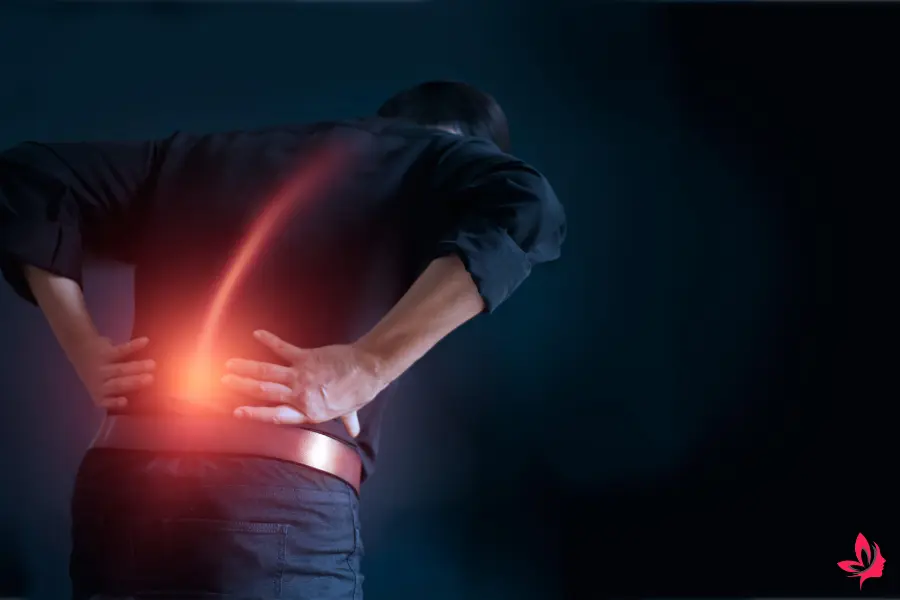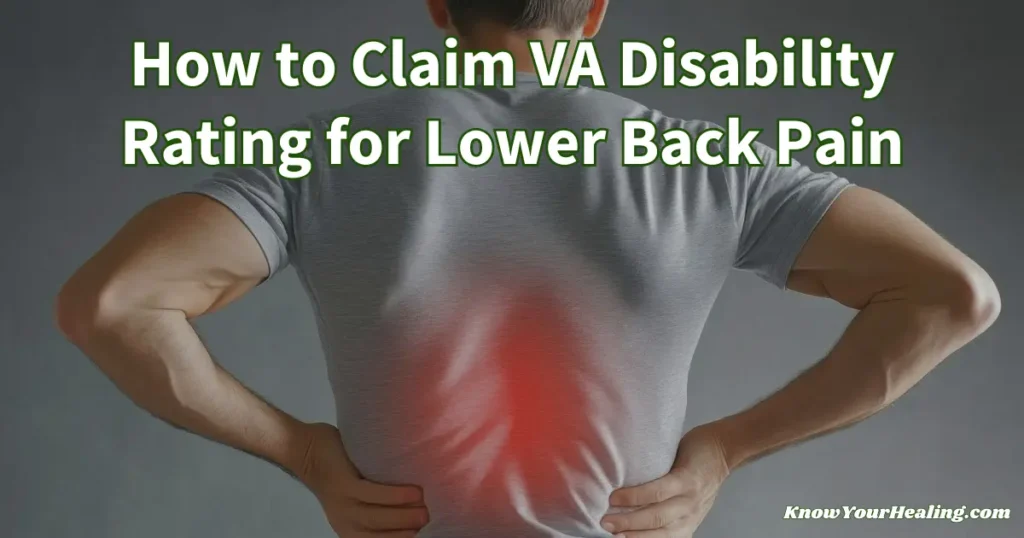VA disability rating for lower back pain is a common concern for many veterans who struggle with daily discomfort and mobility issues.
Knowing how to claim a proper VA disability rating for lower back pain can open the door to tax-free monthly benefits and support.
This guide explains the steps veterans need to take, what medical evidence to gather, and what to expect during the claims process.
Lower back pain affects how veterans live and work. Understanding how the VA evaluates and rates these conditions is important.
Even if the pain seems minor or intermittent, veterans may still qualify for benefits. The VA considers both the severity and the impact on daily life, as outlined in its written rules.
Understanding VA Disability Rating for Lower Back Pain

VA disability rating for lower back pain is based on medical evidence and the impact of symptoms on daily activities. The VA uses specific criteria to determine benefits and compensation.
The process considers severity, medical records, and functional loss to inform decisions.
What Is a VA Disability Rating for Lower Back Pain and How It Works
The VA disability rating for lower back pain measures how much a veteran’s condition limits their ability to work and perform daily tasks. VA rates back pain from 10% to 100%, depending on severity and range of motion issues.
The main goal is to link the back injury or chronic pain to service-connected disabilities from active duty military service.
A board of veterans reviews a veteran’s claim, which must include evidence such as a nexus letter and current diagnosis. The process also considers past and ongoing medical treatment, physical therapy, and any functional loss caused by lower back pain.
The VA uses a general rating formula that considers forward flexion of the thoracolumbar spine, ankylosis, and abnormal spinal contour. A higher rating is possible if the disability is severe or affects the entire spine.
Common Spine Conditions and Injuries of the Spine Affecting VA Ratings
Many types of back pain and spine conditions affect VA ratings. The most common include lumbosacral strain, degenerative disc disease, spinal stenosis, intervertebral disc syndrome, and nerve damage affecting the lower extremities.
Chronic low back pain or severe back pain caused by active service may qualify as a service-connected disability. Specific findings, such as abnormal gait, abnormal spinal contour, or unfavorable ankylosis of the thoracolumbar spine, should appear in medical records.
Some cases involve secondary service connection, where back pain causes new problems, such as radiculopathy, or affects quality of life. If the injury causes a disability that prevents a veteran from working, a higher percentage disability rating or total disability could be awarded under VA guidelines.
The Role of Medical Records and Medical Evidence in Your VA Disability Claim
Substantial medical evidence is key in a veteran’s claim for VA disability benefits. This evidence starts with diagnosis and treatment records from active service and continues with recent reports from VA treatment records and private providers.
Medical records should show the history and progression of the back condition. Statements from doctors, physical examinations, C&P exams (Compensation and Pension exams), and imaging tests all add to the file.
Relevant evidence could include proof of muscle spasm, abnormal spinal findings, or evidence of assistive devices. Medical evidence helps the Department of Veterans Affairs regional office understand the severity of the condition, total functional loss, and any secondary conditions.
Accurate records can support requests for a higher rating. Disabled veterans should keep these documents up to date and share new test results with the VA before the rating decision or the expiration date.
How Muscle Spasm and Painful Motion Impact Your VA Rating
Muscle spasm and painful motion play a significant role in the VA’s decision process. Symptoms such as painful motion, cramps, or difficulty with forward flexion of the thoracolumbar spine are considered during the physical examination and C&P examination.
These findings may limit the range of motion, increase abnormal spinal contour, or cause abnormal gait. Each of these symptoms affects the percentage rating for lower back pain.
Consistent reports of muscle spasm or chronic pain can justify a higher rating if daily activities or military duties are limited. Veterans who experience muscle spasms with abnormal spinal contour or guard their movements often receive at least the minimum rating.
Severe, frequent, or disabling muscle spasm events can raise the disability rating, especially when combined with other findings.
Overview of the General Rating Formula and Percent Rating for Back Pain
The VA uses the general rating formula for diseases and injuries of the spine, as outlined in 38 C.F.R., to determine the percentage rating for lower back pain. The formula measures loss of motion, the presence of ankylosis, and any neurological findings associated with the back condition.
Ratings are assigned according to the degree of functional limitation. A rating of 10% might be applied for a slight restriction. In comparison, a rating of 40% or higher could be given for unfavorable ankylosis of the entire thoracolumbar spine or severe chronic pain.
The highest rating is reserved for total immobilization of the spine or, in exceptional cases, for veterans who are unable to work due to a back injury that renders them unable to perform any work. Veterans can review details about VA disability ratings for back pain to understand how their specific condition is evaluated.
Steps to File a Successful VA Disability Claim for Lower Back Pain

The VA disability rating for lower back pain depends on substantial medical evidence and the thoroughness of the claim documentation. Focusing on medical examinations, service connections, and thorough records will help demonstrate the severity of the condition and its impact on daily life.
Gathering Relevant Evidence: Medical Examinations and VA Treatment Records
Building a strong VA disability claim for lower back pain begins with collecting relevant evidence. This includes detailed medical records from both private doctors and VA facilities that may document chronic low back pain, muscle spasm, or degenerative disc disease.
Reports from physical therapy, assistive devices, or changes in daily activities should be included. Veterans should gather X-rays, MRI results, doctor’s notes, and statements about how back conditions limit their range of motion or cause painful motion.
VA treatment records are vital because the VA places significant weight on its exams and findings. Supporting documentation of previous injuries to the spine or evidence of pain during active duty will directly connect the condition to military service.
Consistency in these records can make the difference between a low rating and a higher rating from the VA.
How to Prepare for Your C&P Exam and VA Examination
The Compensation and Pension (C&P) exam is a key step in the VA disability claims process. Veterans should be ready to describe their symptoms, such as severe back pain, abnormal gait, or loss of movement in the lower extremities.
Preparation involves creating a list of symptoms and how they limit physical activities, such as standing, sitting, or lifting. Being honest about the actual impact on quality of life is important.
Bringing a trusted person, like a spouse or fellow American veteran witness, can help describe the daily effects of the service-connected disability. Applicants should be aware of how the VA examiner evaluates spine conditions, including measuring the range of motion of the thoracolumbar spine, assessing for abnormal spinal contour, and checking for neurological findings.
Mentioning the need for physical therapy or the use of assistive devices may further support the veteran’s claim for a higher percentage disability rating.
Using a Nexus Letter and Medical Evidence to Prove Service-Connected Disability
A nexus letter establishes a connection between the veteran’s lower back pain and their service. This medical evidence is provided by a doctor who explains how military duties or a specific back injury contributed to the current disability.
Details should reference the veteran’s service-connected disabilities while providing a clear link to the back condition. The letter should indicate whether the pain or spine injuries began or worsened during active service.
The most convincing letters reference diagnostic code language, such as lumbosacral strain or intervertebral disc syndrome. These letters may also mention how chronic pain affects employment.
Submitting strong medical examinations and a clear nexus letter often leads to a more favorable rating decision.
Understanding the Importance of the Decision Date and Findings of Fact
The decision date is the day the VA issues its official rating decision. Any VA benefits, including back pay, may be determined by this date.
Findings of fact from the Department of Veterans Affairs Regional Office are based on evidence of record, including VA examination reports. These findings determine the average VA disability rating for lower back pain by comparing results to the general rating formula under 38 C.F.R.
Key evidence includes documented functional loss, forward flexion of the thoracolumbar spine, or unfavorable ankylosis of the entire thoracolumbar spine. Veterans must review the rating decision carefully for any missed evidence or errors.
How Secondary Conditions and Functional Loss Affect Your VA Claims
Secondary conditions are health issues caused or worsened by your service-connected lower back pain. Examples include nerve damage, spinal stenosis, or problems in the cervical spine and lower extremities.
Documenting these secondary service connection issues is vital for an increased rating. The veteran should gather medical records showing how chronic pain and functional loss, such as trouble maintaining employment or abnormal posture, affect daily activities.
In some cases, a veteran may qualify for total disability if back conditions and secondary symptoms limit almost all physical demands of military service or civilian work. Each condition linked to the original back injury should be clearly outlined on the official VA disability claim form.
Maximizing Your VA Disability Benefits and Ratings

The VA disability rating for lower back pain is determined by medical evidence, the impact of the pain on daily activities, and the severity of the condition. Veterans can take several steps to increase their chances of receiving a higher rating and securing proper compensation.
How to Request an Increased Rating or Higher Rating for Chronic Low Back Pain
To increase a percent rating for chronic low back pain, a veteran must show that the disability has worsened or was underrated. This process begins by filing a new VA Form 21-526EZ and providing new medical records that document changes in pain level and limitations.
If a veteran notices more frequent muscle spasms, reduced range of motion of the thoracolumbar spine, or increased use of assistive devices, this should be documented. The VA uses the general rating formula for back conditions to evaluate claims.
Necessary evidence includes the results of a VA examination (C&P exam), findings of fact, any abnormal gait or abnormal spinal contour, and how the disability affects daily activities and work. If a rating decision does not accurately reflect the full severity of the condition, the veteran may request reconsideration or appeal.
Some veterans may need to take their case to the Board of Veterans Appeals (BVA) for exceptional cases, especially if their back injury is complex or involves secondary conditions like nerve damage or spinal stenosis.
The BVA reviews the entire disability picture, including medical evidence, the impact of the service-connected disability on the lower extremities, and results from any recent physical examination.
A detailed nexus letter from a doctor, along with service-connected medical records, can strengthen a veteran’s claim. The appeal may involve submitting updated evidence or demonstrating that the current rating does not accurately reflect the severity of the condition.
Impact of Physical Therapy, Assistive Devices, and Daily Activities on Your Rating
Physical therapy and the use of assistive devices—such as braces or canes—show the VA how much a spine condition limits a veteran’s daily life.
Medical records should include any physical therapy treatments, ongoing functional loss, or needed mobility aids.
Daily activities, such as walking, lifting, or working, factor into how the VA rates a back disability.
Muscle spasm, painful motion, and unfavorable ankylosis of the thoracolumbar spine can affect the percentage disability rating.
Detailed descriptions of how back pain impacts quality of life and the ability to do military duties or maintain employment help improve the accuracy of the VA rating.
Understanding VA Disability Compensation and Percent Disability Rating
VA disability compensation for lower back pain is based on the extent to which the disability interferes with daily activities, work, or self-care.
Ratings usually start at 10% and can go up to 100% for severe cases such as unfavorable ankylosis or total disability involving the entire spine.
Intervertebral disc syndrome and degenerative disc disease may lead to higher ratings.
The VA rates disability claims under 38 C.F.R. § 4.71a, which covers injuries of the spine, including lumbosacral strain and conditions affecting the cervical and thoracolumbar spine.
Veterans should review their VA treatment records and rating decision notice to understand their current percentage disability rating and determine how it aligns with their symptoms.
Tips for Veterans on Maintaining Gainful Employment Despite Back Conditions
Many veterans with service-connected disabilities want to keep working but face challenges from lower back pain.
Requesting job accommodations, such as adaptive seating, flexible hours, or reduced physical demands, can be based on medical evidence and restrictions.
Stay in contact with the Department of Veterans Affairs regional office for information about vocational rehabilitation.
Documenting limits during military or civilian duties, as well as how chronic pain interferes with work, supports requests for higher ratings and job adjustments.
Participating in regular physical therapy and following medical advice can improve function and reduce the risk of further injury.
Frequently Asked Questions
Lower back pain is one of the most common reasons veterans file for VA disability.
Understanding ratings, secondary conditions, and the necessary evidence can improve a veteran’s chances of a successful claim.
What is the average VA rating for lower back pain?
The average VA disability rating for lower back pain typically ranges from 10% to 20%.
Ratings depend on how much the pain limits a person’s movement and ability to perform daily functions.
Some cases with severe mobility issues may be rated higher, while cases with mild symptoms may be rated lower.
What is the VA rating for L4, L5, and L5 S1 degenerative disc disease?
Degenerative disc disease of the L4, L5, or L5 S1 is rated under the same schedule as other back and spine injuries.
Ratings consider the range of motion, ankylosis, and the effects of pain or nerve problems.
These ratings can range from 10% to 60%, depending on the degree of spine flexibility limitation and the presence of significant nerve involvement.
How to Increase VA Disability for Lower Back Pain?
A veteran can request an increase in their VA disability rating if symptoms have worsened.
This typically requires medical evidence, such as updated doctor reports or imaging results, that demonstrate increased pain or more severe loss of movement.
Veterans can submit new or additional evidence when requesting a higher rating or appealing a decision.
What conditions are secondary to lower back pain?
Conditions often secondary to lower back pain include sciatica, radiculopathy, depression, sleep disorders, and some gastrointestinal issues.
If lower back pain causes or worsens another health problem, that secondary condition can also be claimed for benefits.
How do I prove my back pain to the VA?
Veterans need medical records, doctor’s notes, and imaging results to support their claim.
Keeping a log of symptoms and how back pain affects daily life can also be helpful.
Submitting strong medical evidence and details about how the service contributed to the back pain can improve the odds of receiving benefits.
What is the VA rating for sciatica in the lower back?
Lower back sciatica is rated based on the severity of nerve impairment.
Ratings often fall between 10% and 40%, depending on the degree of paralysis and the extent to which the condition interferes with movement or daily activities.
What is the easiest VA disability to get approved for?
Musculoskeletal conditions, like strains and mild joint pain, are among the most common disabilities approved by the VA.
These conditions are well-documented and frequently occur in service.
Each claim is unique, and approval also depends on the medical evidence and the service connection.
Is arthritis in the lower back a VA disability?
Yes, arthritis in the lower back is recognized as a service-connected disability by the VA.
The condition must be proven to have been caused or worsened by military service.
Ratings depend on the impact of arthritis on spinal movement and daily life.
What is the VA rating for erectile dysfunction?
The VA generally assigns a 0% rating for erectile dysfunction if it is not severe enough to affect daily functioning but recognizes it as a service-connected issue.
Veterans can receive special monthly compensation for loss of use, even if the VA disability rating is zero.
What is the C&P exam for back pain?
The Compensation and Pension (C&P) exam for back pain is a medical evaluation conducted by a VA or contracted doctor. The exam checks the history and severity of the back pain.
The doctor also examines the limits of movement and looks for any nerve or secondary symptoms related to the back pain. The results help decide the correct disability rating for the veteran.
What is the VA rating for a lower lumbar strain?
A lower lumbar strain is typically rated at 10% or 20%, depending on the degree of motion loss and the level of pain.
Severe, lasting limits can increase the rating.
What is the VA rating for chronic pain?
The VA does not assign a special rating for chronic pain alone. They rate it based on how much it limits movement and function.
If a doctor diagnoses chronic pain as a specific back condition or as part of another condition, it may qualify for a higher percentage.




